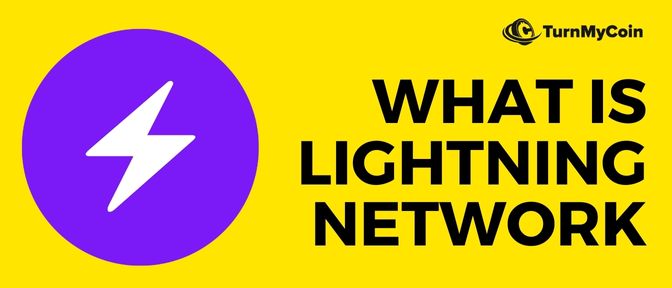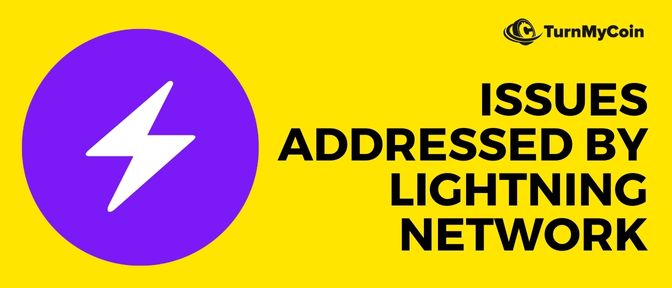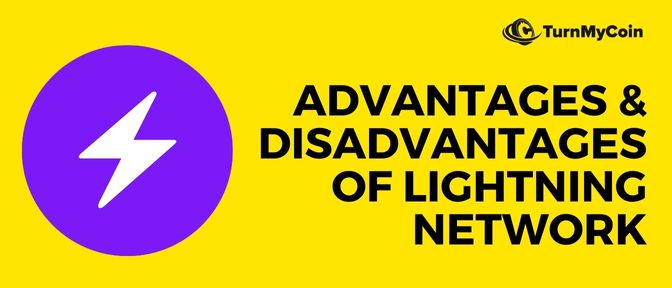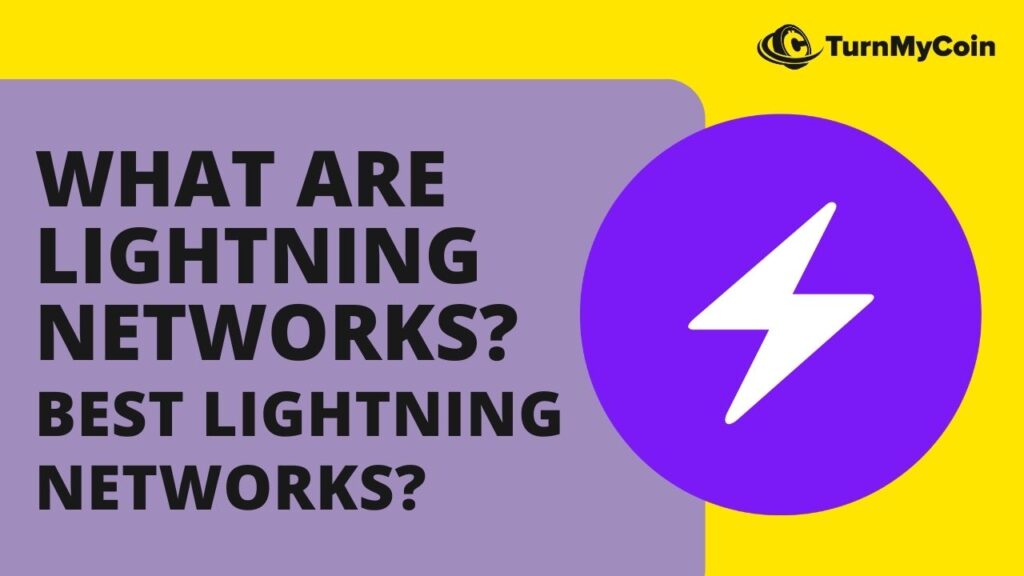Last updated on March 7th, 2023 at 11:58 am
Introduction
The Lightning Network is a second-layer payment protocol. It allows users to make transactions with reduced fees, faster confirmation times and increased privacy. It implements a “payment channel” on top of the bitcoin blockchain.
This means that instead of waiting for multiple confirmations before transacting with your counterparty, you can:
- Send them bitcoin and
- Instantly receive it back
The Lightning Network is a decentralized payment channel system that allows users to make off-chain payments through smart contracts.
These channels are designed for:
- Micropayments or small transactions with low fees
What Is Lightning Network?

Bitcoin was designed as a decentralized payment system where users could remain anonymous and access it from anywhere when it first came out.
It was not meant to be scalable. But to address that problem that as more people use the network, the transaction fees rise and the confirmation time increases. This means that people have to wait longer to receive their payments and pay higher fees for them.
Lightning Network was created to fix these problems. The Lightning Network is a second-layer solution built on Bitcoin or another blockchain.
It allows users to make transactions off-chain without relying on miners for confirmation. Instead, they rely on other nodes in the network to check whether or not two parties have enough funds.
Before proceeding with the transaction, these nodes must confirm that the parties have sufficient funds.
It was proposed by Joseph Poon and Thaddeus Dryja in their white paper, “The Bitcoin Lightning Network: Scalable OTC Micropayments and Atomic Swap.”
This white paper outlines the details of the Lightning Network and how it aims to improve upon traditional bitcoin transactions.
It uses smart contract functionality within the bitcoin blockchain to create a new payment channel. The Lightning network aims to make transactions faster, cheaper, and more private than typical bitcoin transactions.
History Of Lightning Network

The Lightning Network as mentioned above was proposed in 2015 by two researchers, Thaddeus Dryja and Joseph Poon, in a paper titled The Bitcoin Lightning Network.
The goal of the network is to allow for micropayments between nodes on a blockchain. This makes it possible for users to send small amounts of money without incurring fees or waiting for transactions to be confirmed.
Dryja and Poon describe the Lightning Network as a decentralized system that can create “micropayment channels” between parties who want to transact with each other. These channels are opened among the parties involved and closed when no more transactions occur.
This allows faster payments without waiting for miners’ confirmation or using up space on a blockchain ledger.
The Lightning Network is a new way of using Bitcoin that will enable millions of transactions per second. Bitcoin has struggled to process more than seven transactions per second in the past, which is far too low for it to be used as a mainstream currency.
To address this problem, Joseph Poon and Thaddeus Dryja proposed the idea of the Lightning Network in their white paper “The Bitcoin Lightning Network: Scalable Off-Chain Instant Payments” in 2015. In the article, they detail how they believe this new system will be able to handle millions or even billions of transactions per second by sending them off-chain instead of on-chain.
This means that instead of every transaction being recorded on the blockchain every time someone sends something using bitcoin. Only two transactions are recorded:
- One when users agree to how much bitcoin they’re sending each other (called an “opening commitment transaction”) and
- One when they close that agreement (called a “closing commitment transaction”).
What Issues Does It Try to Address?

The Lightning Network attempts to correct several issues that Bitcoin has struggled with. These issues are speed in confirming transactions, scalability, and privacy. We have already mentioned them earlier in this article, however, they are now discussed in detail in the words below.
Scalability
One of the main issues that Lightning Network aims to address is the scalability of blockchain networks. The Bitcoin blockchain, for example, is currently limited to processing a maximum of around seven transactions per second.
This is a relatively low number compared to traditional payment networks like Visa, which can handle thousands of transactions per second.
The Lightning Network attempts to overcome this limitation by allowing transactions to be processed off-chain. This means that transactions are sent directly between participating nodes instead of being recorded on the blockchain.
This allows for much higher transaction throughput since the blockchain is only used for settling up large numbers of transactions at once rather than for every individual transaction.
High Fees
Another issue that the Lightning Network addresses are the high fees often associated with blockchain transactions. Because block space is limited on the Bitcoin blockchain, users must compete with each other to have their transactions included in the next block. This can lead to bidding wars, with users offering increasingly high fees to incentivize miners to include their transactions.
The Lightning Network addresses this issue by allowing users to create payment channels between themselves, which they can use to make unlimited transactions without incurring fees. Since the transactions are only recorded on the blockchain when the payment channel is closed, users can create as many transactions as they want without paying fees.
Security
In addition to addressing scalability and high fees, the Lightning Network also aims to improve the overall security of blockchain networks. Because transactions on the Lightning Network are processed off-chain, they are not subject to the same level of protection as transactions on the blockchain.
However, the Lightning Network uses sophisticated cryptographic techniques to ensure that transactions are secure and cannot be reversed once they are made.
The Lightning Network has the potential to make blockchain technology more accessible and valuable for a broader range of applications.
How does the Lightning Network work?

In order to understand it better, I am enclosing a guide to discuss how the lightning network works here.
Here is a step-by-step guide on how the Lightning Network works
- Two or more parties agree to open a payment channel on the Lightning Network. This involves sending a small amount of funds to a multi-signature address, a type of Bitcoin address requiring more than one signature to access the funds.
- The parties can now send and receive payments to each other without having to broadcast each transaction to the entire network. This allows for faster and cheaper transactions, as the fees and confirmation times are much lower on the Lightning Network compared to the main blockchain.
- The parties can keep the payment channel open for as long as they like and make as many transactions as they want. However, each transaction must be signed by both parties to be valid.
- When the parties are ready to close the payment channel, they can do so by broadcasting the final balance of the track to the blockchain. The network confirms this last transaction, and the funds are released to the respective parties.
- The Lightning Network also allows for the creation of payment channels between multiple parties. This is called a “network” of payment channels and allows even more efficient and scalable transactions.
Best Lighting Networks Wallet

As the popularity of Bitcoin and blockchain technology continues to grow, so does the need for efficient and secure payment methods.
One of the critical components of the Lightning Network is the wallet, which is used to store and manage your funds. In this part, we will explore some of the best Bitcoin Lightning Network wallets currently available.
1. Eclair Wallet
Eclair Wallet is an open-source, Lightning Network-compatible wallet developed by ACINQ. It is available for Android and iOS devices and offers a simple and user-friendly interface.
Eclair Wallet allows users to efficiently manage their Lightning Network channels and transactions and send and receive Bitcoin payments.
2. BlueWallet
BlueWallet is another popular Lightning Network wallet available for Android and iOS devices. It offers a sleek and intuitive design and is easy for both beginners and experienced users.
BlueWallet allows users to manage their Lightning Network channels easily, send and receive payments, and access various other features, such as tracking Bitcoin prices and generating QR codes for transactions.
3. Breez
Breez is a Lightning Network wallet that provides a seamless and fast payment experience. It is available for Android and iOS devices and offers a simple and user-friendly interface.
Breez allows users to manage their Lightning Network channels easily, send and receive payments, and access various other features, such as tracking Bitcoin prices and generating QR codes for transactions.
4. Zap Wallet
Zap Wallet is a Lightning Network wallet available for desktop and mobile devices. It offers a simple and user-friendly interface and allows users to easily manage their Lightning Network channels and transactions.
Zap Wallet also provides various other features, such as tracking Bitcoin prices, generating QR codes for transactions, and accessing a built-in exchange to swap between different cryptocurrencies.
5. Phoenix
Phoenix is a Lightning Network wallet available for desktop and mobile devices. It offers a sleek and intuitive design and is easy for both beginners and experienced users.
Phoenix allows users to manage their Lightning Network channels easily, send and receive payments, and access various other features, such as tracking Bitcoin prices and generating QR codes for transactions.
6. Zeus
Zeus is a Lightning Network wallet that provides a secure and private payment experience. It is available for desktop and mobile devices and offers a simple and user-friendly interface.
Zeus allows users to manage their Lightning Network channels easily, send and receive payments, and access various other features, such as tracking Bitcoin prices and generating QR codes for transactions.
7. Wallet of Satoshi
The wallet of Satoshi is a Lightning Network wallet available for Android and iOS devices. It offers a simple and user-friendly interface and allows users to easily manage their Lightning Network channels and transactions.
Wallet of Satoshi also provides various other features, such as tracking Bitcoin prices, generating QR codes for transactions, and accessing a built-in exchange to swap between different cryptocurrencies.
The Lightning Network offers a fast and efficient way to transact with Bitcoin, and these wallets provide a secure and user-friendly way to manage your funds and conduct transactions. Whether you are a beginner or an experienced user, there is a Lightning Network wallet that is right for you.
Advantages and Disadvantages of Lightning Network

As the popularity & use of Lightning Network grows there are a set of people who talk about its shortcomings too. In the paragraphs below, we will discuss the advantages and disadvantages of the lightning network.
Advantages of Lightning Network
- One of the main advantages of the Lightning Network is its ability to improve the speed of transactions significantly. Because transactions are made off-chain, they are not subject to the same network congestion as on-chain transactions, which can take longer to be processed.
This makes the Lightning Network ideal for applications that require fast and efficient transactions, such as online gaming and micropayments. - Another advantage of the Lightning Network is its low transaction fees. Because transactions are made off-chain, they do not require the same computational power to process as on-chain transactions.
Transaction fees can be significantly lower on the Lightning Network, making it an attractive option for users looking to save money on fees.
Disadvantages of Lightning Network
- New Technology: However, there are also some drawbacks to using the Lightning Network. One of the main disadvantages is that it is still a relatively new technology yet to be widely adopted. This means that not all merchants and services support the Lightning Network, which can limit its usefulness for some users.
- Security: Additionally, because transactions on the Lightning Network are not recorded on the blockchain. So they are not as secure as on-chain transactions. This can make them more vulnerable to fraud and other malicious activity.
- Not fully decentralized: Another disadvantage of the Lightning Network is that it still needs to be fully decentralized. While it does not rely on a central authority to process transactions. The network still depends on a small number of nodes to function correctly. If these nodes were to go offline, the network could be disrupted, potentially causing delays or even transaction failures.
Conclusion
In conclusion, the Lightning Network is a layer 2 payment protocol built on blockchain networks, such as Bitcoin and Litecoin.
It allows for faster and cheaper transactions by creating a network of payment channels between participants. These channels can be opened and closed anytime, allowing flexibility and scalability.
Lightning network wallets are software programs enabling users to interact with the Lightning Network and manage their funds. These wallets are essential for participating in the Lightning Network and transactions on the network.


